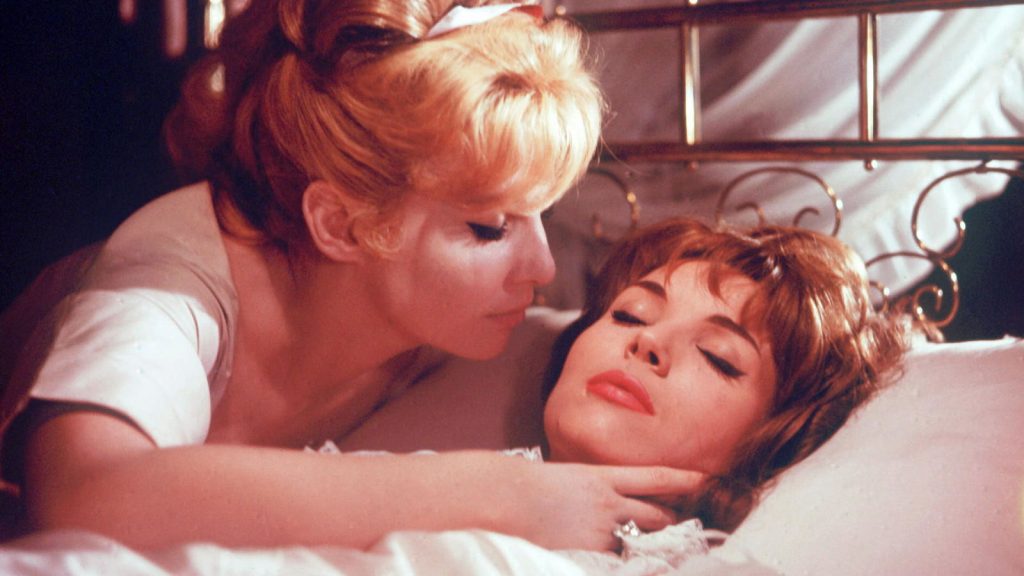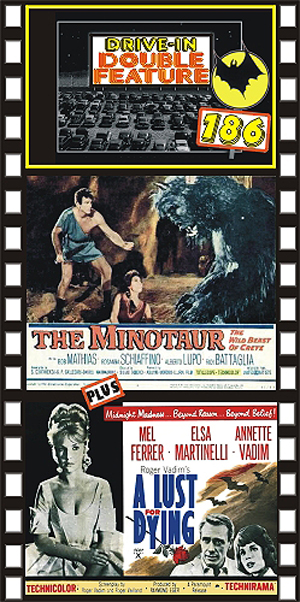
A Lust for Dying (aka- Blood and Roses) (France, 1960) 78 min color DIR: Roger Vadim. PROD: Raymond Eger. SCR: Claude Brulé, Claude Martin, Roger Vadim; based on Carmilla, by Sheridan Le Fanu. DOP: Claude Renoir. MUSIC: Jean Prodromides. CAST: Mel Ferrer, Elsa Martinelli, Annette Vadim (aka- Annette Stroyberg), Marc Allégret. (Paramount)

Sheridan Le Fanu’s 1872 Gothic horror novella, Carmilla, has been adapted for the screen numerous times, in such varied results as Carl Theodor Dreyer’s Vampyr, Roy Ward Baker’s The Vampire Lovers, and Camillo Mastrocinque’s underrated Crypt of the Vampire. One of the most satisfying is this visually beautiful “arthouse horror”, updating the setting to modern-day Italy, with some post-WW2 sensibilities.
The Karnstein family name is haunted by links to vampirism; the bratty girls Martha and Marie still make jokes about it, and Carmilla remarks about her own likeness to her ancestor Millarca. The picturesque Karnstein homestead has a splendrous party to celebrate the engagement of Carmilla’s cousin Leopoldo (Mel Ferrer) to her best friend Georgia (Elsa Martinelli). Fireworks accidentally trigger an explosion from leftover munitions buried during the war, which dislodges an old crypt. Carmilla investigates the crypt, and re-emerges the next morning, henceforth bringing the family curse to the present.
To be honest, I can take or leave a lot of Roger Vadim’s filmography. His characteristically risqué material often becomes tiresome by the third act (yes, even in Barbarella!). In this film, however, he directs with a subtlety and sensuality that compliments the delicate screenplay. For my money, this and his war melodrama Vice and Virtue are his most satisfying pictures.
The breathtaking colour cinematography of Claude Renoir (previously evidenced in his uncle Jean Renoir’s films, The River and The Golden Coach) is of great use here, especially the spellbinding scene (done in near silence) where Carmilla discovers the crypt: the backlighting and mood are as good as anything by Mario Bava.
The film’s quiet tone is among its great virtues, not just in that mesmerizing sequence, but also in the subtle changes we witness of Carmilla. Animals (especially her beloved horse) behave differently around her; she even later confesses to her loss of passion, as if to suggest that she is dead already. Annette Stroyberg (once Annette Vadim, who also starred in her then-husband’s Les Liaisons Dangereuses 1960) is very effective as the central character of Carmilla, haunted by a mordant destiny.
Because this is 1960, the lesbian undertones of the Carmilla story are less explicit than in the later Hammer versions. Instead, one could undergo a lot of Freudian analysis in the later, elaborate dream sequence, in which the colour is drained, except for red, presented in a manner evocative of Cocteau’s fantasies. Arguably, more perversely explicit is Leopold’s attraction to his cousin: how he looks at her while Georgia undresses her the night after the party, and starts kissing her passionately in a later scene until he controls himself. (Vadim must’ve had a thing for cousins; check out his instalment in Spirits of the Dead.)
The print on review here is the French language version (it was also simultaneously shot in English), presented in widescreen, although with German title credits in black and white! Although set in Italy, the onscreen dialogue is in French- even a tombstone’s inscription is in French! The multicultural presentation of this version gives a feeling of disorientation found in many 1960s European productions: what world is this taking place in?
This European cut features the wraparound narrative by Dr. Verari (René-Jean Chauffard) telling the story of Carmilla while on a plane. Normally, these plot structures don’t work, because the person guiding the narrative is describing scenes in which they aren’t participants, especially when death occurs. (Dr. Verari is a party guest, but his character is secondary to the central dynamic.) However, here it works in a fashion that recalls much of the earliest horror literature that was often related in a fable-like, diaristic style.
This film is featured on Vol. #186 of Sinister Cinema’s ever-popular Drive-In Double Feature series, paired with a widescreen version of the peplum, Minotaur, the Wild Beast of Crete, on a single DVD-R. The disc opens with trailers, and a collection of intermission bumpers between the two films. In keeping with the theme of that film, one greenish trailer is for 1960’s Tarzan The Magnificent, featuring Gordon Scott, who would soon be a peplum star in his own right. Fittingly, this trailer seems to tie into the sword and sandal market with intertitles claiming that Tarzan has “The Courage of Hercules” and “The Strength of Samson”. Other trailers include the immortal Steve Reeves in Morgan the Pirate, and something called African Slave Girls.